Laying piece parquet: technology of work + analysis of 3 popular layouts
It is difficult to argue that piece parquet is one of the most presentable and reliable materials for flooring. He is beautiful and natural, which is valuable at all times. A competent laying of piece-type parquet flooring will allow you to call yourself the owner of an almost eternal flooring without false modesty. Piece parquet is produced, for the most part, without varnishing - this feature is its important difference from semi-finished products, such as parquet boards or solid wood. Do you want the floors in your house to be decorated with this particular material? So you, for sure, will be curious to know how to lay a piece of parquet with your own hands.
Preparation of the base for laying
So, you have already chosen the parquet itself, along the way, naturally, having decided on the type of wood of the dice and the pattern of the future coating. Now you can start preparing the rough floor.
Elimination of differences with leveling compounds
Concrete base or screed level if necessary. But how do you know if there is such a need? To do this, you need to go over the entire surface of the building with a metal rail - if the gap between it and the floor in certain places exceeds 2 mm, then these areas are processed with a grinder or mixture.
It is the unevenness of the floor in most cases that is the root cause of the creak of the parquet - therefore, experts advise approaching this stage as responsibly as possible. The cracks present should also be repaired with the help of special compounds.
Waterproofing device
If you had to partially or fully form a new screed, remember that it should be dried - accordingly, during the work you will have to withstand a significant pause.
As a waterproofing agent, a layer of either a reactive primer or an epoxy resin is applied to the surface. Then the entire floor area is primed with a special composition.
Installation of moisture resistant plywood or OSB
The rough floor for piece parquet is a board or sheets of moisture-proof plywood, mounted on logs or directly on the screed. Concerning plywood subfloor, then for its arrangement you will need material from 8 to 20 millimeters thick, cut into squares of 50 × 5o (75 × 75). Plywood is laid on glue (brickwork), while a five-millimeter gap should remain between the individual elements. For a more durable connection of the material with the base, self-tapping screws are also used.
It is important that buyers very often interpret the concept of moisture-proof plywood is not entirely true. For some reason, it seems to many that such material must necessarily be processed with something from above. But this is not so. In moisture-proof plywood, the layers are connected by special adhesives, without external impregnation. Moisture-resistant coated plywood, of course, exists, but its intended purpose is by no means the arrangement of rough floors for piece parquet (the reason is its poor adhesion with parquet adhesives).
Laying methods for piece parquet
Well, now is the time to go on to study the intricacies of coating installation. Consider the most popular ways to create a floor pattern from piece parquet. Due to the small size of the individual coating elements, various types of material can be used for laying.For example, if you are sure that the furniture will not be rearranged in the room for many years, you can lay out cheaper parquet under it. In the most prominent places in the room, the best, selected dies are simply obliged to show off.
Option # 1 - herringbone layout
This installation method is not only very beautiful, but also as stable as possible. For herringbone floors, a uniform load distribution on the slats is characteristic - the risk of crevice formation is minimal.
Before laying, the room with a strong cord is divided in half - strictly in the middle. Piles of material are placed on both sides of it and only then they begin to install the so-called “lighthouse tree” - a parquet strip of two rows of dies. Its assembly is extremely inconvenient - all the slats crawl, a solid fulcrum is missing. Therefore, the first link of 5-6 elements is usually collected dry aside.
Then, well-mixed mastic (or glue) is poured with a thin stream along the cord, distributed on the surface in the form of a strip with a width slightly exceeding the size of the Christmas tree to be laid, and the starting structure is transferred to the specified position.
Note! The right row should be located clearly angles to the cord - the left, respectively, will lie under the guide. Planks are laid with a ridge "to oneself".
When installing this "benchmark", you should be extremely accurate, simultaneously tracking the tightness of the dies - until the parquet is securely grasped with the base, you can spoil the fruits of your work in no time. The slightest distortion of the picture is fraught - up to the complete unsuitability of the entire coverage area.
Further laying continues to the right and left of the lighthouse, row by row approaching the side walls. The installation is crowned by the installation of a frieze - a decorative parquet composition, framing the perimeter of the coating area (you can do without it). The technology of laying piece parquet “herringbone” does not exclude the installation of a lighthouse diagonally (the so-called “oblique tree”).
Option # 2 - deck laying
This is the top-end method for installing piece parquet today. Deck laying is simpler than the herringbone, but the floors obtained as a result are not stable (low resistance to atmospheric changes).
The technology of the “deck” implies the displacement of the dies by 1/2 or 1/3. To create a playful design of the floor, a French run is used. In this case, parquet elements of various lengths or even widths (!) Are used without a fixed offset. In the final (impassable) rooms, the slats are placed with the long side perpendicular to the door, in the passage or corridor - in the direction of movement.
To find out how much parquet you will need with this type of installation, you can use our calculator:
Option # 3 - Square Laying
This installation is of two types:
- "Vietnamese" - a straight square;
- expanded square.
In the first case, the parquet planks are parallel to the walls of the room. The lighthouse row is mounted:
- in square rooms - against the wall opposite the doors;
- in elongated (rectangular) - along one of the long walls.
Video manual with an example of installation work
This video demonstrates laying parquet on the screed (“herringbone” method).
Properly choosing the method of laying piece parquet, it is possible to emphasize all the advantages of the room, while hiding its disadvantages.And strict observance of installation technology will allow you to enjoy not only the impeccable appearance of the floor covering, but also the quality of its operation.

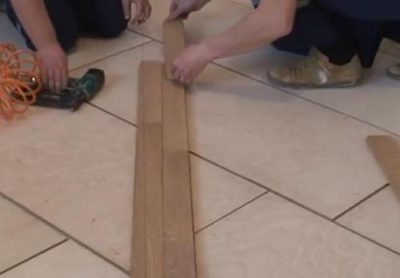

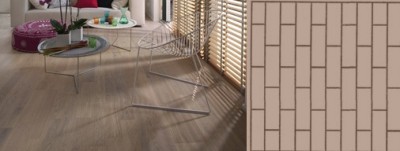
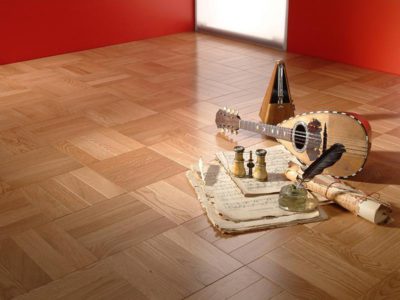

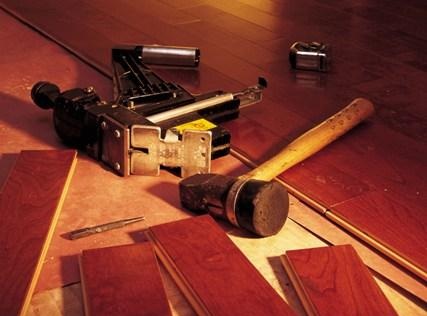
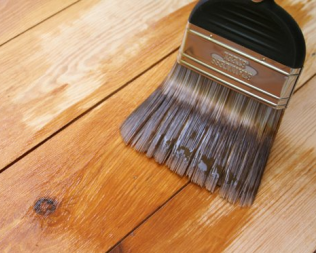
2 comments